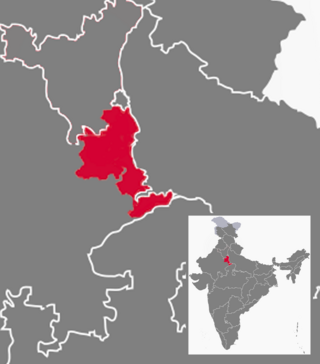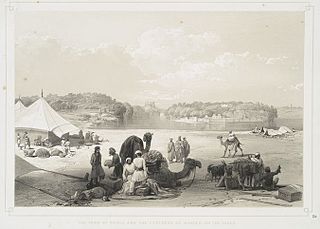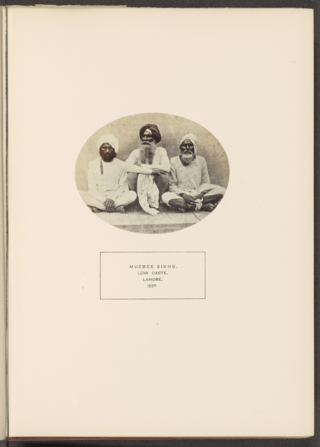Related Research Articles

Arya Samaj is a monotheistic Indian Hindu reform movement that promotes values and practices based on the belief in the infallible authority of the Vedas. The samaj was founded by the sannyasi (ascetic) Dayanand Saraswati in the 1870s.

Khatri is a caste originating from the Punjab region of South Asia that is predominantly found in India, but also in Pakistan and Afghanistan. In the Indian subcontinent, they were mostly engaged in mercantile professions such as banking and trade. They were the dominant commercial and financial administration class of late-medieval India. Some in Punjab often belonged to hereditary agriculturalist land-holding lineages, while others were engaged in artisanal occupations. Khatris of Punjab specifically were scribes and traders. They secured good employment in the Mughal imperial service by several of them taking membership in the Madrasas and learning Persian.

The Aravalli Range is a mountain range in Northern-Western India, running approximately 670 km (420 mi) in a south-west direction, starting near Delhi, passing through southern Haryana, Rajasthan, and ending in Ahmedabad Gujarat. The highest peak is Guru Shikhar on Mount Abu at 1,722 m (5,650 ft). The Aravalli Range is arguably the oldest geological feature on Earth, having its origin in the Proterozoic era.

Mewat is a historical and cultural region which encompasses parts of the modern-day states of Haryana, Rajasthan, and Uttar Pradesh in north-western India.

Arora is a community of Punjab, comprising both Hindus and Sikhs. The name is derived from their native place Aror. In 712, the Arora people left Aror and started to settle in the cities of Punjab.

British Punjab was a province of British India. Most of the Punjab region was annexed by the British East India Company on 29 March 1849, and declared a province of British colonial rule; it was one of the last areas of the Indian subcontinent to fall under British control. In 1858, the Punjab, along with the rest of British Raj, came under the direct colonial rule of the British Crown. It had a land area of 358,355 square kilometers.

Punjabi Hindus are adherents of Hinduism who identify ethnically, linguistically, culturally, and genealogically as Punjabis and are natives of the Punjab region of the Indian subcontinent. Punjabi Hindus are the second-largest religious group of the Punjabi community, after the Punjabi Muslims. While Punjabi Hindus mostly inhabit the Indian states of Punjab, Haryana, Himachal Pradesh, Delhi, and Chandigarh today, many have ancestry across the greater Punjab region, which was partitioned between India and Pakistan in 1947.

Mazhabi Sikh is a community from Northern India, especially Punjab region, who follow Sikhism. Mazhabi are part of wider category of Sikhs, who convert from the hindu rangrette. The word Mazhabi is derived from the Arabic term mazhab, and can be translated as the faithful. They live mainly in Indian Punjab, Rajasthan and Haryana.
The economy of Punjab is the 16th largest state economy in India with ₹8.02 lakh crore (US$100 billion) (FY2024-25) in gross domestic product and a per capita GDP of US$3460(264,000) ranking 19th amongst Indian states.
Numbardar or Lambardar is a title in the Indian subcontinent which applies to powerful families of zamindars of the village revenue estate, a state-privileged status which is hereditary and has wide-ranging governmental powers share in it, the collaboration with the police for maintaining law and order in the village, and it comes with the associated social prestige. In contrast, the Zaildar who was the grand jagirdar and usually had the power over 40 to 100 villages. The Zail and Zaildar system of British Raj was abolished in 1952 in India but the lambardar system still continues in Pakistan and in some places in India.
The Mirasi are a community found in North India and Pakistan. They are folklore tellers and traditional singers and dancers of a number of communities. The word "mirasi" is derived from the Arabic word (ميراث) mīrās, which means inheritance or sometimes heritage. In the strict grammatical sense of the term, they are considered to be propagators of the cultural and social heritage.

The Singh Sabha Movement, also known as the Singh Sabha Lehar, was a Sikh movement that began in Punjab in the 1870s in reaction to the proselytising activities of Christians, Hindu reform movements and Muslims. The movement was founded in an era when the Sikh Empire had been dissolved and annexed by the British, the Khalsa had lost its prestige, and mainstream Sikhs were rapidly converting to other religions. The movement's aims were to "propagate the true Sikh religion and restore Sikhism to its pristine glory; to write and distribute historical and religious books of Sikhs; and to propagate Gurmukhi Punjabi through magazines and media." The movement sought to reform Sikhism and bring back into the Sikh fold the apostates who had converted to other religions; as well as to interest the influential British officials in furthering the Sikh community. At the time of its founding, the Singh Sabha policy was to avoid criticism of other religions and political matters.
The Pachhada are a Muslim ethnic group found in the Pakistani Punjab. They are also known as Rath.

Sir Charles Montgomery Rivaz was a colonial administrator in British India, and Lieutenant-Governor of the Punjab 1902-1907.
Forests Department, Haryana is a department of the Government of Haryana, a state in India, that runs and maintains many protected nature areas in the state of Haryana. It has two administrative divisions: Forest and Wildlife. The department is responsible for maintaining National Parks, Wildlife Sanctuaries and Conservation Reserves in Haryana. It also provides a special emphasis on Soil and Moisture Conservation works in the hills to conserve water and deliver it to adjacent farmlands. Two National Parks, eight Wildlife Sanctuaries, two Conservation Reserves, four Animal & Bird Breeding Centres, one Deer park, and 49 herbal parks. Kanwar Pal Gujjar has been the cabinet minister responsible for this department since October 2019. constitute the Protected Area network of the department, covering 0.75% of the state. It also maintains a list of Protected Areas in Haryana.
The Jat people are a traditionally agricultural community in Northern India and Pakistan. Originally pastoralists in the lower Indus river-valley of Sindh, Jats migrated north into the Punjab region in late medieval times, and subsequently into the Delhi Territory, northeastern Rajputana, and the western Gangetic Plain in the 17th and 18th centuries. Of Hindu, Muslim and Sikh faiths, they are now found mostly in the Indian states of Punjab, Haryana, Uttar Pradesh and Rajasthan and the Pakistani provinces of Sindh and Punjab.
Punjabi nationalism is an ideology which emphasizes that the Punjabis are one nation and promotes the cultural unity of Punjabis around the world. The demands of the Punjabi nationalist movement are linguistic, cultural, economic and political rights.
The Punjab Canal Colonies is the name given to parts of western Punjab which were brought under cultivation through the construction of canals and agricultural colonisation during the British Raj. The Punjab underwent an agricultural revolution, with arid subsistence production getting replaced by commerce-oriented production of huge amounts of wheat, cotton and sugar. Between 1885 and 1940, nine canal colonies were created in the inter-fluvial tracts west of the Beas and Sutlej and east of the Jhelum rivers. In total, over one million Punjabis settled in the new colonies, relieving demographic pressures in central Punjab.

Sir Malcolm Lyall Darling was a member of the Indian Civil Service (ICS) who was appointed Assistant Commissioner of the Punjab, British India, in 1904. Having held numerous other posts, he became Financial Commissioner of the same province in 1936 and retired from the ICS in 1940. Thereafter, he was engaged in various roles, including as chairman of the Horace Plunkett Foundation, and was for some time head of the BBC India Section.
Sindh Land Alienation Bill of 1947 was a piece of legislation introduced by the British Sindh Assembly, with the aim of returning the mortgaged land to the owners, Similar to the Punjab Land Alienation Act of 1900.
References
Notes
- ↑ Kenneth Jones says that Charles Rivaz was Lieutenant-Governor of the Punjab in 1899 but this is incorrect. He succeeded William Mackworth Young in that office in 1902.
- ↑ Hindus had traditionally been dominant in government offices but competition for such jobs became tougher from the 1880s for a variety of reasons rooted both in policy and in demographic changes. The Aitchison Commission was significant in this development. [3]
Citations
- ↑ British law and caste identity manipulation in colonial India: the Punjab Alienation of Land Act., Guilhem Cassan, Paris School of Economics (PSE), Laboratoire d’Economie Appliqu´ee (LEA-INRA) and Centre de Sciences Humaines de Delhi (CSH), 12 January 2010
- ↑ Why Dera Sacha Sauda draws followers, Sanjeev Nayar, Rediff, 28 August 2017
- 1 2 3 Jones (1976), pp. 182–183
- ↑ Nair (2011), p. 13
- ↑ Jones (1976), pp. 247–248
- ↑ Jones (1976), p. 249
- ↑ Nair (2011), p. 71
- ↑ Nair (2011), p. 6
- ↑ Law changes bring Aravalli conservation to the fore, Hindustan Times, 22 December 2019.
Bibliography
- Jones, Kenneth W. (1976), Arya Dharm: Hindu Consciousness in 19th-century Punjab, University of California Press, ISBN 978-0-52002-920-0
- Nair, Neeti (2011), Changing Homelands, Harvard University Press, ISBN 978-0-67406-115-6